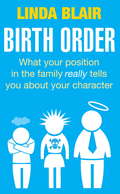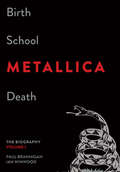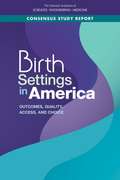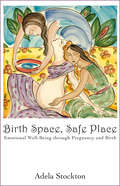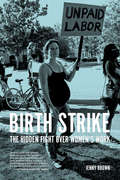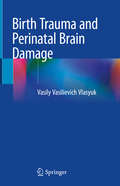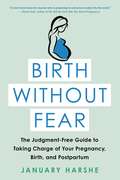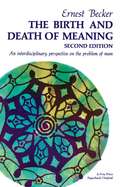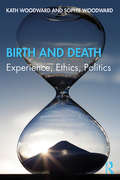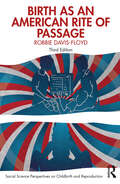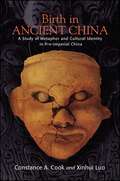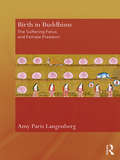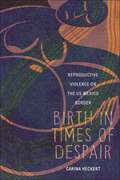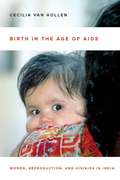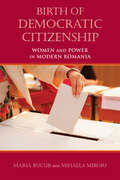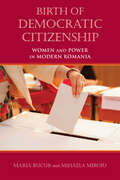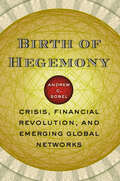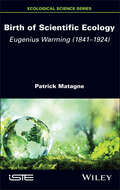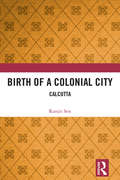- Table View
- List View
Birth Order: What your position in the family really tells you about your character
by Linda BlairOn the basis of over 25 years' clinical experience and psychological research, Linda Blair reveals how your birth order position, as well as the spacing between you and your siblings and the sex of your siblings, impact your childhood, your adult life and your relationships.Packed with new research and written in a lively, personal style, Birth Order will inform and intrigue. By reading this unique book you will quickly understand yourself, your family and your partner better. It will also shed light on the dynamics of your other relationships, explain why you may repeat patterns within relationships, and suggest helpful strategies for dealing with other people. Chapters cover birth order and what being the eldest, middle, or youngest child reveals about you, the effect of large or small age gaps between you and your siblings, family size, the sex of your siblings, parental attitudes to each child, being an only child, being a twin, the impact of step-siblings, and much more.
Birth Order: What your position in the family really tells you about your character
by Linda BlairOn the basis of over 25 years' clinical experience and psychological research, Linda Blair reveals how your birth order position, as well as the spacing between you and your siblings and the sex of your siblings, impact your childhood, your adult life and your relationships.Packed with new research and written in a lively, personal style, Birth Order will inform and intrigue. By reading this unique book you will quickly understand yourself, your family and your partner better. It will also shed light on the dynamics of your other relationships, explain why you may repeat patterns within relationships, and suggest helpful strategies for dealing with other people. Chapters cover birth order and what being the eldest, middle, or youngest child reveals about you, the effect of large or small age gaps between you and your siblings, family size, the sex of your siblings, parental attitudes to each child, being an only child, being a twin, the impact of step-siblings, and much more.
Birth Partner Handbook
by Carl JonesThe Birth Parter Handbook is a concise, contemporary guide for today's birth partners, showing them exactly what they can do to help create a positive birth experience, whether the mother gives birth naturally or with medication, at home, in a childbearing center, or in a hospital. With a special emphasis on the psychological changes of labor, this guide also introduces a new approach to understanding labor made popular through the author's nationwide childbirth workshops, called the "laboring mind response." Birth partners will gain new insight into the mother's altered state of mind and altered behavior during labor, and be given an easy-to-follow, eight-step method that teaches the mind to cooperate with the body and will help make childbirth less stressful and more natural for the mother.
Birth Plans For Dummies
by Rachel Gurevich Sharon Perkins RnThe easy, trusted way to develop a birth planAs an expectant mother and parent, navigating all of the information and options for labor and delivery can be cumbersome and confusing. Birth Plans For Dummies, is the ultimate resource guide to help you understand, develop, and implement a plan for the birth of your baby.A birth plan is a communication tool for expectant mothers and those involved in the delivery of a child. The plan explains the mother's preferences for labor and delivery and eliminates any confusion. There are a wide variety of methods, strategies, and techniques available to pregnant women preparing for delivery--and this hands-on, friendly guide covers them all.Covers choosing the setting and method that best fits the mothers needs and wishesInforms expectant parents about the numerous pain management and labor intervention optionsProvides instruction on developing and writing a birth plan and putting it into actionIf you are an expectant mother or parent looking for a guide to help develop a plan for the birth of your child, then Birth Plans For Dummies is the perfect book for you.
Birth School Metallica Death, Volume 1: The Biography
by Paul Brannigan Ian WinwoodThere has never been a hard rock band like Metallica. The California quartet has sold more than 100 million albums worldwide, won nine Grammy Awards, and had five consecutive albums hit number one on the Billboard charts. But Metallica's story, epic in scope, is a tale about much more than sales figures and critical acclaim, and their journey from scuzzy Los Angeles garages to the world's most storied stadiums has been dramatic and painful, their gigantic successes often shot through with tension, tragedy, loss, and controversy.Birth School Metallica Death is the definitive story of the most significant rock band since Led Zeppelin. Volume 1 covers the band's formation up to their breakthrough eponymous fifth album, aka "The Black Album." The intense and sometimes fraught relationship between aloof-yet-simmering singer, chief lyricist, and rhythm guitarist James Hetfield and the outspoken and ambitious drummer Lars Ulrich is the saga's emotional core. Their earliest years saw the release of three unimpeachable classics-Kill 'Em All, Ride the Lightning, and Master of Puppets-genre-defining masterpieces that took hard rock to a new level, both artistically and commercially. During these tumultuous times, the band persevered through line-up changes when guitarist Dave Mustaine was replaced by Kirk Hammet, and their bass player, the beloved Cliff Burton, was tragically killed in a bus crash while on tour in Europe.But it was the breakthrough of ...And Justice for All that rent the fabric of the mainstream, hitting the top of the charts without benefit of radio airplay or the then-crucial presence on MTV. And finally in 1991, with the release of their fifth studio album, nicknamed "The Black Album," Metallica hit the next level-five hit singles including their best-known songs "Enter Sandman" and "Nothing Else Matters"-and their first album atop the Billboard charts.In Birth School Metallica Death, veteran music journalists and Metallica confidants Paul Brannigan and Ian Winwood detail this meteoric rise to international fame in an epic saga of family, community, self-belief, the pursuit of dreams, and music that rocks. Told through first-hand interviews with the band and those closest to them, the story of Metallica's rise to the mainstream has never been so vividly documented.
Birth Settings in America: Outcomes, Quality, Access, And Choice
by Engineering Medicine National Academies of SciencesThe delivery of high quality and equitable care for both mothers and newborns is complex and requires efforts across many sectors. The United States spends more on childbirth than any other country in the world, yet outcomes are worse than other high-resource countries, and even worse for Black and Native American women. There are a variety of factors that influence childbirth, including social determinants such as income, educational levels, access to care, financing, transportation, structural racism and geographic variability in birth settings. It is important to reevaluate the United States' approach to maternal and newborn care through the lens of these factors across multiple disciplines. Birth Settings in America: Outcomes, Quality, Access, and Choice reviews and evaluates maternal and newborn care in the United States, the epidemiology of social and clinical risks in pregnancy and childbirth, birth settings research, and access to and choice of birth settings.
Birth Space, Safe Place
by Adela StocktonFocusing on the wide spectrum of feelings that may arise when with child, this companion to the emotional journey caused by pregnancy, birth, and early parenting offers informative resources and homeopathic remedies for both parents-to-be and childbirth practitioners. With advice about laying fears to rest, keeping birth gentle, and protecting the baby-moon, this hand-held doula helps couples face the choices on their journey to parenthood as well as adjust to their new roles as parents, all the while emphasizing the spiritual journey of birth by putting the mother's emotional and spiritual needs before her physical requirements. Proposing that the experience of childbirth has the capacity to nourish rather than replete the soul, the book encourages women to take responsibility for their own birthing process and to surrender to their own instinctive powers rather than to those of medical intervention.
Birth Strike: The Hidden Fight over Women's Work
by Jenny BrownWhen House Speaker Paul Ryan urged U.S. women to have more children, and Ross Douthat requested "More babies, please," in a New York Times column, they openly expressed what U.S. policymakers have been discussing for decades with greater discretion. Using technical language like "age structure," "dependency ratio," and "entitlement crisis," establishment think tanks are raising the alarm: if U.S. women don't get busy having more children, we'll face an aging workforce, slack consumer demand, and a stagnant economy. Feminists generally believe that a prudish religious bloc is responsible for the protracted fight over reproductive freedom in the U.S., and that politicians only attack abortion and birth control to appeal to those "values voters." But hidden behind this conventional explanation is a dramatic fight over women's reproductive labor. On one side, elite policymakers want an expanding workforce reared with a minimum of employer spending and a maximum of unpaid women's work. On the other side, women are refusing to produce children at levels desired by economic planners. By some measures our birth rate is the lowest it has ever been. With little access to childcare, family leave, health care, and with insufficient male participation, U.S. women are conducting a spontaneous birth strike. In other countries, panic over low birth rates has led governments to underwrite childbearing and childrearing with generous universal programs, but in the U.S., women have not yet realized the potential of our bargaining position. When we do, it will lead to new strategies for winning full access to abortion and birth control, and for improving the difficult working conditions U.S. parents now face when raising children.
Birth Trauma and Perinatal Brain Damage
by Vasily Vasilievich Vlasyuk<p>This book focuses on traumatic birth injuries, predominantly of the skull and brain, as well as hemorrhagic and ischemic disorders of cerebral circulation in fetuses and newborns, providing information on each condition’s classification, incidence, etiology and pathogenesis, pathomorphology, clinic, diagnostics, prognosis, and complications. It discusses the configuration (molding) of the head, venous congestion, displacements of cranial bones, ruptures of the cerebellar tentorium during labor, and the compression of the skull and brain damage caused by obstetric operations and asynclitic insertion of the head, while also describing the importance of the periosteal stagnation of the skull to assess the delivery and explanation of tentorium tears. Intracranial hemorrhages are considered in detail, taking into account the role of the traumatic factor in their occurrence and hypoxic-ischemic brain lesions (periventricular leukomalacia, selective neuronal necrosis, multicystic encephalomalacia, etc.). <p>Lastly, it offers the world’s first explanation of why tentorium tears occur most frequently in the left half, providing an original classification of damaged tentoria, subarachnoid and intraventricular hemorrhages, and the degree of configuration of the head in childbirth. <p>Given the depth and breadth of its coverage, the book offers an essential resource for neonatologists, obstetricians-gynecologists, perinatologists, pediatric neurologists, pathologists, pediatricians, forensic experts and neuroimaging professionals.</p>
Birth Without Doctors: Conversations with traditional midwives (Health and Population Set)
by Jacqueline Vincent-PriyaMost women giving birth in rural communities throughout the Third World cannot enjoy the ''benefits'' of modern medical assistance. They are usually too expensive and too far away. This book is the result of journeys and conversations between the author, traditional midwives and mothers which took place over several years in Malaysia and Indonesia. It describes traditional birthing practices and the communities in which they have arisen. For normal births the safety record is impressive, but so too is the reassurance of ritual and the incorporation of birthing into family and society. It is interesting to discover that many practices are based not only on religious understandings but also on sound herbal medical precautions. The book's point is not merely to demonstrate the skill of the traditional midwives, nor even to challenge what seems to be the medical view that pregnancy is an illness, but to give an insight into worlds where ''barefoot'' midwifery is the norm. Originally published in 1991
Birth Without Fear: The Judgment-Free Guide to Taking Charge of Your Pregnancy, Birth, and Postpartum
by January HarsheAn inclusive, non-judgmental, and empowering guide to pregnancy, childbirth, and postpartum life that puts mothers first, offering straightforward guidance on all the options and issues that matter most to them (and their partners) when preparing for a baby. In Birth Without Fear, January Harshe--founder of the global online community Birth Without Fear--delivers an honest, positive, and passionate message of empowerment surrounding everything that involves having a baby. It's a guide that fills in the considerable cracks in the information available to women and families when they're preparing to welcome a child--covering care provider choices, medical freedom, birth options, breastfeeding, intimacy, postpartum depression, and much more. Birth Without Fear shows moms, dads, partners, and families how to choose the best provider for them, how to trust in themselves and the birth process, and how to seek the necessary help after the baby has arrived. In addition, it will educate them about their rights--and how to use their voice to exercise them--as well as how to cope with the messy postpartum feelings many people aren't willing to talk about. Unlike other pregnancy books, Birth Without Fear will also help partners understand what mothers are going through, as well as discuss the challenges that they, too, will face--and how they can navigate them. Shattering long-held myths and beliefs surrounding pregnancy, birth, and the postpartum experience, Birth Without Fear is an accessible, reassuring, and ultimately inspiring guide to taking charge of pregnancy, childbirth, and beyond.
Birth and Death of Meaning (Pelican Ser.)
by Ernest BeckerUses the disciplines of psychology, anthropology, sociology and psychiatry to explain what makes people act the way they do.
Birth and Death: Experience, Ethics, Politics
by Sophie Woodward Kath WoodwardUsually conceived in opposition to each other – birth as a hopeful beginning, death as an ending – this book brings them into dialogue with each other to argue that both are central to our experiences of being in the world and part of living. Written by two authors, this book takes an intergenerational approach to highlight the connections and disconnections between birth and death; adopting a relational approach allows the book to explore birth and death through the key relationships that constitute them: personal and social, private and public, the affective and social norms, the actual and the virtual and the ordinary and profound. Of interest to academics and students in the fields of feminism, phenomenology and the life course, the book will also be of relevance to policy makers in the areas of birth activism and end of life care. Drawing from personal stories, everyday life and publicly contested examples, the book will also be of interest to a more general readership as it engages with questions we all at some point will grapple with.
Birth as an American Rite of Passage
by Robbie E. Davis-FloydWhy do so many American women allow themselves to become enmeshed in the standardized routines of technocratic childbirth--routines that can be insensitive, unnecessary, and even unhealthy? Anthropologist Robbie Davis-Floyd first addressed these questions in the 1992 edition. Her new preface to this 2003 edition of a book that has been read, applauded, and loved by women all over the world, makes it clear that the issues surrounding childbirth remain as controversial as ever.
Birth as an American Rite of Passage (Social Science Perspectives on Childbirth and Reproduction)
by Robbie Davis-FloydThis classic book, first published in 1992 and again in 2003, has inspired three generations of childbearing people, birth activists and researchers, and birth practitioners—midwives, doulas, nurses, and obstetricians—to take a fresh look at the "standard procedures" that are routinely used to "manage" American childbirth. It was the first book to identify these non-evidence-based obstetric interventions as rituals that enact and transmit the core values of the American technocracy, thereby answering the pressing question of why these interventions continue to be performed despite all evidence to the contrary. This third edition brings together Davis-Floyd's insights into the intense ritualization of labor and birth and the technocratic, humanistic, and holistic models of birth with new data collected in recent years.
Birth in Ancient China: A Study of Metaphor and Cultural Identity in Pre-Imperial China (SUNY series in Chinese Philosophy and Culture)
by Constance A. Cook Xinhui LuoUsing newly discovered and excavated texts, Constance A. Cook and Xinhui Luo systematically explore material culture, inscriptions, transmitted texts, and genealogies from BCE China to reconstruct the role of women in social reproduction in the ancient Chinese world. Applying paleographical, linguistic, and historical analyses, Cook and Luo discuss fertility rituals, birthing experiences, divine conceptions, divine births, and the overall influence of gendered supernatural agencies on the experience and outcome of birth. They unpack a cultural paradigm in which birth is not only a philosophical symbol of eternal return and renewal but also an abiding religious and social focus for lineage continuity. They also suggest that some of the mythical founder heroes traditionally assumed to be male may in fact have had female identities. Students of ancient history, particularly Chinese history, will find this book an essential complement to traditional historical narratives, while the exploration of ancient religious texts, many unknown in the West, provides a unique perspective into the study of the formation of mythology and the role of birthing in early religion.
Birth in Buddhism: The Suffering Fetus and Female Freedom (Routledge Critical Studies in Buddhism)
by Amy Paris LangenbergRecent decades have seen a groundswell in the Buddhist world, a transnational agitation for better opportunities for Buddhist women. Many of the main players in the transnational nuns movement self-identify as feminists but other participants in this movement may not know or use the language of feminism. In fact, many ordained Buddhist women say they seek higher ordination so that they might be better Buddhist practitioners, not for the sake of gender equality. Eschewing the backward projection of secular liberal feminist categories, this book describes the basic features of the Buddhist discourse of the female body, held more or less in common across sectarian lines, and still pertinent to ordained Buddhist women today. The textual focus of the study is an early-first-millennium Sanskrit Buddhist work, "Descent into the Womb scripture" or Garbhāvakrānti-sūtra. Drawing out the implications of this text, the author offers innovative arguments about the significance of childbirth and fertility in Buddhism, namely that birth is a master metaphor in Indian Buddhism; that Buddhist gender constructions are centrally shaped by Buddhist birth discourse; and that, by undermining the religious importance of female fertility, the Buddhist construction of an inauspicious, chronically impure, and disgusting femininity constituted a portal to a new, liberated, feminine life for Buddhist monastic women. Thus, this study of the Buddhist discourse of birth is also a genealogy of gender in middle period Indian Buddhism. Offering a new critical perspective on the issues of gender, bodies and suffering, this book will be of interest to an interdisciplinary audience, including researchers in the field of Buddhism, South Asian history and religion, gender and religion, theory and method in the study of religion, and Buddhist medicine.
Birth in Times of Despair: Reproductive Violence on the US-Mexico Border (Anthropologies of American Medicine: Culture, Power, and Practice #18)
by Carina HeckertExplores forms of maternal harm stemming from US policies on the US-Mexico borderIn El Paso, Texas, the racist undertones of anti-immigrant sentiment have contributed to various forms of violence in the region, including the 2019 mass shooting that was the deadliest attack on Latinos in US history. As the community continued to mourn this tragedy, the COVID-19 pandemic unleashed yet another set of economic, social, and public health catastrophes that were disproportionately felt within the border region.In Birth in Times of Despair, Carina Heckert traces women’s emotional experiences of pregnancy, birth, and the postpartum period in the midst of a series of longstanding and ongoing crises in the US-Mexico border region. Drawing from interviews, surveys, and medical records of women who gave birth during an intense period of sociopolitical crisis, she examines how limited access to health care, inhumane immigration policies, and exposure to an array of harmful social environmental circumstances serve as sources of intense harm for pregnant and recently pregnant women. In so doing, Heckert reveals how these experiences serve as a profound critique of policies that continue to fail to protect women and their families. She concludes with suggestions for practical, humane, and urgent policy changes to alleviate the needless suffering of this vulnerable group.With its comprehensive portrait of the abysmal physical and mental health outcomes pregnant women face within the border region, Birth in Times of Despair expands our understanding of how obstetric violence is enhanced by the structural violence of the state, and unveils the urgency to ameliorate the harm caused by current immigration policies.
Birth in the Age of AIDS: Women, Reproduction, and HIV/AIDS in India
by Cecilia Van HollenBirth in the Age of AIDSis a vivid and poignant portrayal of the experiences of HIV-positive women in India during pregnancy, birth, and motherhood at the beginning of the 21st century. The government of India, together with global health organizations, established an important public health initiative to prevent HIV transmission from mother to child. While this program, which targets poor women attending public maternity hospitals, has improved health outcomes for infants, it has resulted in sometimes devastatingly negative consequences for poor, young mothers because these women are being tested for HIV in far greater numbers than their male spouses and are often blamed for bringing this highly stigmatized disease into the family. Based on research conducted by the author in India, this book chronicles the experiences of women from the point of their decisions about whether to accept HIV testing, through their decisions about whether or not to continue with the birth if they test HIV-positive, their birthing experiences in hospitals, decisions and practices surrounding breast-feeding vs. bottle-feeding, and their hopes and fears for the future of their children.
Birth of Democratic Citizenship: Women and Power in Modern Romania
by Maria Bucur Mihaela MiroiuWhat is it like to be a woman living through the transition from communism to democracy? What effect does this have on a woman’s daily life, on her concept of herself, her family, and her community? Birth of Democratic Citizenship presents the stories of women in Romania as they describe their experiences on the journey to democratic citizenship. In candid and revealing conversations, women between the ages of 24 and 83 explain how they negotiated their way through radical political transitions that had a direct impact on their everyday lives. Women who grew up under communism explore how these ideologies influenced their ideas of marriage, career, and a woman’s role in society. Younger generations explore how they interpret civic rights and whether they incorporate these rights into their relationships with their family and community. Beginning with an overview of the role women have played in Romania from the late 18th century to today, Birth of Democratic Citizenship explores how the contemporary experience of women in postsocialist countries developed. The women speak about their reliance on and negotiations with communities, ranging from family and neighbors to local and national political parties. Birth of Democratic Citizenship argues that that the success of democracy will largely rely on the equal incorporation of women in the political and civic development of Romania. In doing so, it encourages frank consideration of what modern democracy is and what it will need to be to succeed in the future.
Birth of Democratic Citizenship: Women and Power in Modern Romania
by Maria Bucur Mihaela Miroiu“A tour de force . . . speaks powerfully to questions that are being currently debated in Romania, Poland, and Hungary.” —Jeffrey C. Isaac, author of Democracy in Dark TimesWhat is it like to be a woman living through the transition from communism to democracy? What effect does this have on a woman’s daily life, on her concept of herself, her family, and her community? This book presents the stories of women in Romania as they describe their experiences on the journey to democratic citizenship. In candid and revealing conversations, women between the ages of 24 and 83 explain how they negotiated their way through radical political transitions that had a direct impact on their everyday lives. Women who grew up under communism explore how these ideologies influenced their ideas of marriage, career, and a woman’s role in society. Younger generations explore how they interpret civic rights and whether they incorporate these rights into their relationships with their family and community.Beginning with an overview of the role women have played in Romania from the late eighteenth century to today, Birth of Democratic Citizenship explores how the contemporary experience of women in postsocialist countries developed. The women speak about their reliance on and negotiations with communities, ranging from family and neighbors to local and national political parties. Birth of Democratic Citizenship argues that that the success of democracy will largely rely on the equal incorporation of women in the political and civic development of Romania. In doing so, it encourages frank consideration of what modern democracy is and what it will need to be to succeed in the future.
Birth of Hegemony: Crisis, Financial Revolution, and Emerging Global Networks
by Andrew C. SobelWith American leadership facing increased competition from China and India, the question of how hegemons emerge-and are able to create conditions for lasting stability-is of utmost importance in international relations. The generally accepted wisdom is that liberal superpowers, with economies based on capitalist principles, are best able to develop systems conducive to the health of the global economy. In Birth of Hegemony, Andrew C. Sobel draws attention to the critical role played by finance in the emergence of these liberal hegemons. He argues that a hegemon must have both the capacity and the willingness to bear a disproportionate share of the cost of providing key collective goods that are the basis of international cooperation and exchange. Through this, the hegemon helps maintain stability and limits the risk to productive international interactions. However, prudent planning can account for only part of a hegemon's ability to provide public goods, while some of the necessary conditions must be developed simply through the processes of economic growth and political development. Sobel supports these claims by examining the economic trajectories that led to the successive leadership of the Netherlands, Britain, and the United States. Stability in international affairs has long been a topic of great interest to our understanding of global politics, and Sobel's nuanced and theoretically sophisticated account sets the stage for a consideration of recent developments affecting the United States.
Birth of Scientific Ecology: Eugenius Warming (1841 - 1924)
by Patrick MatagneThis book presents a biography of the Danish botanist Eugen Warming. As the author of a treatise on ecology that brought him international recognition, he was able to inspire the first generation of 20th-century European and American ecologists. His innovative approach to nature and his Arctic and tropical missions heralded the birth of a new science and an ecological awareness. As a professor at several Scandinavian universities during a period of intense debate and controversy over evolutionary theories, Eugen Warming vigorously asserted his convictions. Birth of Scientific Ecology presents the image of a man of knowledge and power, recognized by his contemporaries as a founder of ecology and a player in the ecological project of the Kingdom of Denmark at a time when the empires were clashing.
Birth of a Bookworm
by Michel Tremblay Sheila FischmanIn Birth of a Bookworm, Michel Tremblay takes the reader on a tour of the books that have had a formative influence on the birth and early development of his creative imagination; the physical and emotional world of his childhood is celebrated as the fertile ground on which his new, vivid way of seeing and imagining is built.
Birth of a Colonial City: Calcutta
by Ranjit SenLong before Calcutta was ‘discovered’ by Job Charnock, it thrived by the Hugli since times immemorial. This book, and its companion Colonial Calcutta, is a biographical account of the when, the how and the what of a global city and its emergence under colonial rule in the 1800s. Ranjit Sen traces the story of how three clustered villages became the hub of the British Empire and a centre of colonial imagination. He examines the historical and geopolitical factors that were significant in securing its prominence, and its subsequent urbanization which was a colonial experience without an antecedent. Further, it sheds light on Calcutta’s early search for identity — how it superseded interior towns and flourished as the seat of power for its hinterland; developed its early institutions, while its municipal administration slowly burgeoned. A sharp analysis of the colonial enterprise, this volume lays bare the underbelly of the British Raj. It will be of great interest to scholars and researchers of modern history, South Asian history, urban studies, British Studies and area studies.
